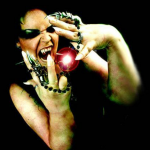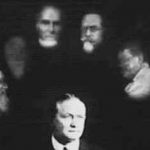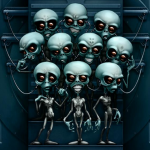The cross-correspondence, devised by Walter and reported by Dr. Mark Wyman Richardson in Psychic Research (May-September 1928) provided more evidence for evaluation, as they seemed to be methodologically sound and provided a fraud-proof technique to bar any eventual allegation of a collusion between experimenters and automatist.
The cross-correspondences occurred in March, 1928; several Chinese scripts came through. R. F. Johnson, of the Society for Psychical Research, attacked them and concluded that: "whoever the communicator on this occasion may have been, he was certainly not the great Chinese sage (Confucius) whose name he adopted. It is also too obvious to need emphasis that the style of the writing is not ancient, that the whole contents of the script consist of ordinary modern Chinese written by a very poor scribe; that both pages of the script contain not a single word or line (barring a trifling exception) that is not a quotation."
Johnson’s critique was answered by Malcolm Bird, who was research officer of the American Soceity for Psychical Research (ASPR). In an article in Psychic Research (August 1929), he pointed to important, unconsidered facts. First, he noted that the scripts did not identify their author as Confucius. Walter never made such a claim. He declared that Chinese spirits, the disciples of Confucius, helped him to get the test through. The important point, he said, was that the scripts were supernormally produced.
Margery delivered the first Chinese script on March 17, 1928, in red light, with closed eyes. She did not know Chinese, nor did the sitters. The very reason of the test was to demonstrate that minds other than the medium and sitters were at work. At the next séance, on March 22, two columns of Chinese were written in total darkness, on specially marked paper. Walter announced that he would try a Chinese-English cross-correspondence with Henry Hardwicke, of Niagara Falls, a distance of 450 miles from Boston.
He asked Bird to pick out a sentence, which should be given through Hardwicke in Chinese. Bird chose "A rolling stone gathers no moss." The sitting was hardly over when a telegram arrived from Niagara Falls. A few days later it was followed by the original witnessed copy of Hardwicke’s script. It showed a Maltese cross within the circle, a rectangle enclosing the name Kung-fu-tze, the symbols for Bird and Hill, and the Chinese sentence, the general meaning of which was, "A travelling agitator gathers no gold." Johnson’s analysis revealed further important element. In the left hand column are found the words, "I am not dead, Confucius." The duplicate of this is in the right hand column of the Margery script of March 17.
In addition to that of Hardwicke, cross-correspondences were effected in Chinese through Sarah Litzelmann, who knew no Chinese either and lived in Ogunquit, Maine, a distance of 80 miles from Boston. Never before had she been in a trance.
In The Story of Psychic Science (1930), Hereward Carrington thus summarized his own conclusions about Margery: "It certainly is one of the most baffling and extraordinary cases in history—and this is true, no matter how we choose to regard it. For my own part I occupy the same position as I did when rendering my formal Report in the Scientific American, which is that, despite the difficulties involved in arriving at any just estimate of this case, and despite the uncertainty of many of the phenomena and the complicated social, ethical, personal, physical and psychological factors involved, a number of seemingly genuine, supernormal manifestations yet remain, which are of the profoundest interest to psychical, as well as to ethico-sociological science."
As parapsychology has moved forward in its appraisal of Margery and other materialization mediums, however, Carrington’s hesitancy appears to be a mixture of credulity and a will to believe.
Few today would attempt a defense of Margery. Possibly the final blow to her reputation came when it was revealed that in 1930 J. Malcolm Bird had submitted a report to the American Society for Psychical Research indicating that he was not only convinced that a measurable portion of the phenomena were fraudulently produced, but that he had been asked to participate in creating it. Shortly after producing that report, Bird resigned and disappeared. The American Society for Psychical Research, which had become committed to Margery, suppressed the report and published another in its place.
However, Crandon continued to perform until her early death on November 1, 1941, at the age of 53.
Sources:
- Berger, Arthur S., and Joyce Berger. The Encyclopedia of Parapsychology and Psychical Research. New York: Paragon House, 1991.
- Bird, J. Malcolm. Margery the Medium. Boston: Small, Maynard, 1925.
- Murchison, Carl A., ed. The Case For and Against Psychical Belief. Worchester, MA: Clark University, 1927. Reprint, New York: Arno Press, 1975.
- ——. Psychical Belief. Worcester, Mass.: Clark University, 1927.
- Tabori, Paul. Companions of the Unseen. London: H. A. Humphrey, 1968. Reprint, London: Souvenir Press, 1972.
- Tietze, Thomas R. Margery. New York: Harper & Row, 1973.








